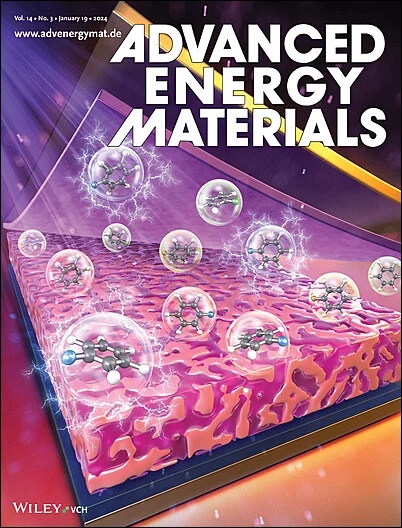An Additive-Assisted Hydrolysis-Blocking Route Enables Thermally Stable Interfacial Chemistry of Silicon-Based Anode Materials in a Rechargeable Lithium Battery
IF 26
1区 材料科学
Q1 CHEMISTRY, PHYSICAL
引用次数: 0
Abstract
Silicon-based anodes are promising for building the next-generation high-energy lithium-ion batteries (LIBs). Currently, the safe use of Si-anode-based LIBs has been hindered by unstable electrolyte chemistry at a high temperature. The thermal decomposition of lithium hexafluorophosphate (LiPF6) and hydrolysis of the decomposition products can generate corrosive species (e.g., HF and POxFy) and exacerbate the surface parasitic reaction of Si, accelerating materials aging and posing challenges to stable Li storage. Here it is shown that the introduction of a functional electrolyte additive, 1,3-Divinyl-1,3-diphenyl-1,3-dimethyldisiloxane (DK244) effectively mitigates the issue. As a Lewis base, DK244 interacted with the Lewis acid PF5 from the thermal decomposition of LiPF6, so it helped to suppress the generation of the corrosive species and improve the high-temperature anode stability against electrolyte. The aging mechanisms of deeply lithiated SiOx/C (x ≈ 1) anodes during calendar storage at 60 °C are studied by using multiscale materials and electrochemical characterizations. The results revealed that DK244 assisted in mitigating the hydrolysis of the electrolyte while maintaining the chemically stable and mechanically robust of solid electrolyte interface so that it contributed to stable Li+ transport after high-temperature storage. The findings provide critical insights into optimizing the anode-electrolyte interface for high-energy and high-temperature-durable LIBs.

添加剂辅助水解阻断途径使可充电锂电池中硅基负极材料的热稳定界面化学成为可能
硅基阳极有望用于制造下一代高能锂离子电池(lib)。目前,硅阳极基锂离子电池的安全使用受到高温下不稳定电解质化学的阻碍。六氟磷酸锂(LiPF6)的热分解和分解产物的水解会产生腐蚀物质(如HF和POxFy),加剧Si的表面寄生反应,加速材料老化,对锂的稳定储存构成挑战。本文表明,引入功能性电解质添加剂1,3-二乙烯基-1,3-二苯基-1,3-二甲基二硅氧烷(DK244)有效地缓解了这一问题。作为Lewis碱,DK244与LiPF6热分解生成的Lewis酸PF5相互作用,有助于抑制腐蚀物质的生成,提高高温阳极对电解质的稳定性。采用多尺度材料和电化学表征方法研究了深度锂化SiOx/C (x≈1)阳极在60°C高温下的老化机理。结果表明,DK244有助于减缓电解质的水解,同时保持固体电解质界面的化学稳定性和机械坚固性,从而有助于高温储存后Li+的稳定运输。这些发现为优化高能和高温耐用的锂离子电池的阳极-电解质界面提供了重要的见解。
本文章由计算机程序翻译,如有差异,请以英文原文为准。
求助全文
约1分钟内获得全文
求助全文
来源期刊

Advanced Energy Materials
CHEMISTRY, PHYSICAL-ENERGY & FUELS
CiteScore
41.90
自引率
4.00%
发文量
889
审稿时长
1.4 months
期刊介绍:
Established in 2011, Advanced Energy Materials is an international, interdisciplinary, English-language journal that focuses on materials used in energy harvesting, conversion, and storage. It is regarded as a top-quality journal alongside Advanced Materials, Advanced Functional Materials, and Small.
With a 2022 Impact Factor of 27.8, Advanced Energy Materials is considered a prime source for the best energy-related research. The journal covers a wide range of topics in energy-related research, including organic and inorganic photovoltaics, batteries and supercapacitors, fuel cells, hydrogen generation and storage, thermoelectrics, water splitting and photocatalysis, solar fuels and thermosolar power, magnetocalorics, and piezoelectronics.
The readership of Advanced Energy Materials includes materials scientists, chemists, physicists, and engineers in both academia and industry. The journal is indexed in various databases and collections, such as Advanced Technologies & Aerospace Database, FIZ Karlsruhe, INSPEC (IET), Science Citation Index Expanded, Technology Collection, and Web of Science, among others.
 求助内容:
求助内容: 应助结果提醒方式:
应助结果提醒方式:


